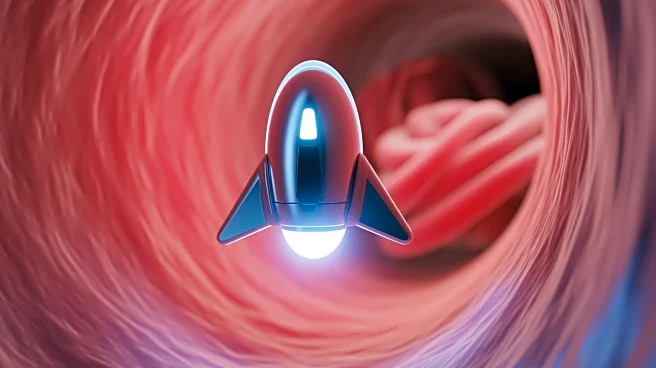What's Happening?
Researchers at ETH Zurich have developed a magnetically guided microrobotic system designed to navigate the body's complex vasculature to deliver drugs with pinpoint accuracy. Led by Fabian Landers, PhD,
the team has integrated an electromagnetic navigation system with a custom release catheter and drug-loaded capsule. This system has been tested in vitro using human vasculature models and in vivo in sheep and pigs, demonstrating its ability to maneuver through blood vessels and cerebrospinal spaces, precisely releasing drugs into targeted tissues. The microrobots are equipped with iron oxide nanoparticles for magnetic properties and tantalum nanoparticles for imaging visibility, allowing for precise control. This innovation aims to minimize unwanted side effects associated with systemic drug administration, which are responsible for 30% of drug failures during clinical trials.
Why It's Important?
The development of these microrobots represents a significant advancement in precision medicine, offering the potential to enhance treatment efficacy by delivering higher concentrations of therapeutic agents directly to disease sites. This targeted approach could reduce the need for high doses that spread throughout the body, thereby minimizing serious side effects such as internal bleeding. The technology holds promise for treating conditions like strokes, localized infections, and tumors, potentially transforming therapeutic strategies and improving patient outcomes. By using materials already FDA-approved for other applications, the system is poised for easier translation into clinical practice, offering new hope for innovative therapies.
What's Next?
The research team plans to move towards human clinical trials, aiming to demonstrate the microrobots' effectiveness in real-world medical settings. The modular design of the robotic platform is expected to simplify adaptation to various clinical workflows, potentially accelerating its adoption in hospitals. As the technology progresses, it could lead to new therapeutic interventions within anatomically constrained regions of the central nervous system, expanding its application beyond thrombosis treatment.
Beyond the Headlines
The ethical implications of using microrobots in medicine include considerations of patient safety, informed consent, and the potential for unforeseen long-term effects. As the technology advances, regulatory frameworks will need to address these concerns to ensure safe and effective implementation. Additionally, the cultural shift towards precision medicine may influence healthcare practices, emphasizing personalized treatment plans and potentially reducing healthcare costs associated with drug side effects.












